How Performance Management Helps Us Build Reliable Development Teams
Updated 07 Jul 2023
12 Min
4495 Views
Efficient results can be achieved only if everything goes like a clockwork. Do you agree? It is highly important to organize teamwork in a proper way so it helps improve workflow and increase stability in the interaction process with employees. That is why it is advisable to use a performance management strategy which enables to build a better software development services team.
What is performance management exactly and how can it be used wisely? We will provide you with all the details in this article.
Why performance management is important for IT companies
Performance management is the way to implement set strategies and turns plans into concrete results. Performance management can be presented as a conception that combines widely used methodologies for business improvement. Performance management combines the entire management cycle from planning to control, and it helps understand how to evaluate software developers performance. This methodology can be represented as a set of solutions that has three main functions:
- data collection;
- analysis and model building on it's basis;
- keeping up with a built model.
Performance management goal is to make the right decisions and the accuracy of decisions should be proved by results of the activity. The basis of this system is the aspiration to increase the quality of services and working process as well as build the right team. There are 5 steps in the performance management cycle that IT companies should follow persistently. You can find them on the picture below.
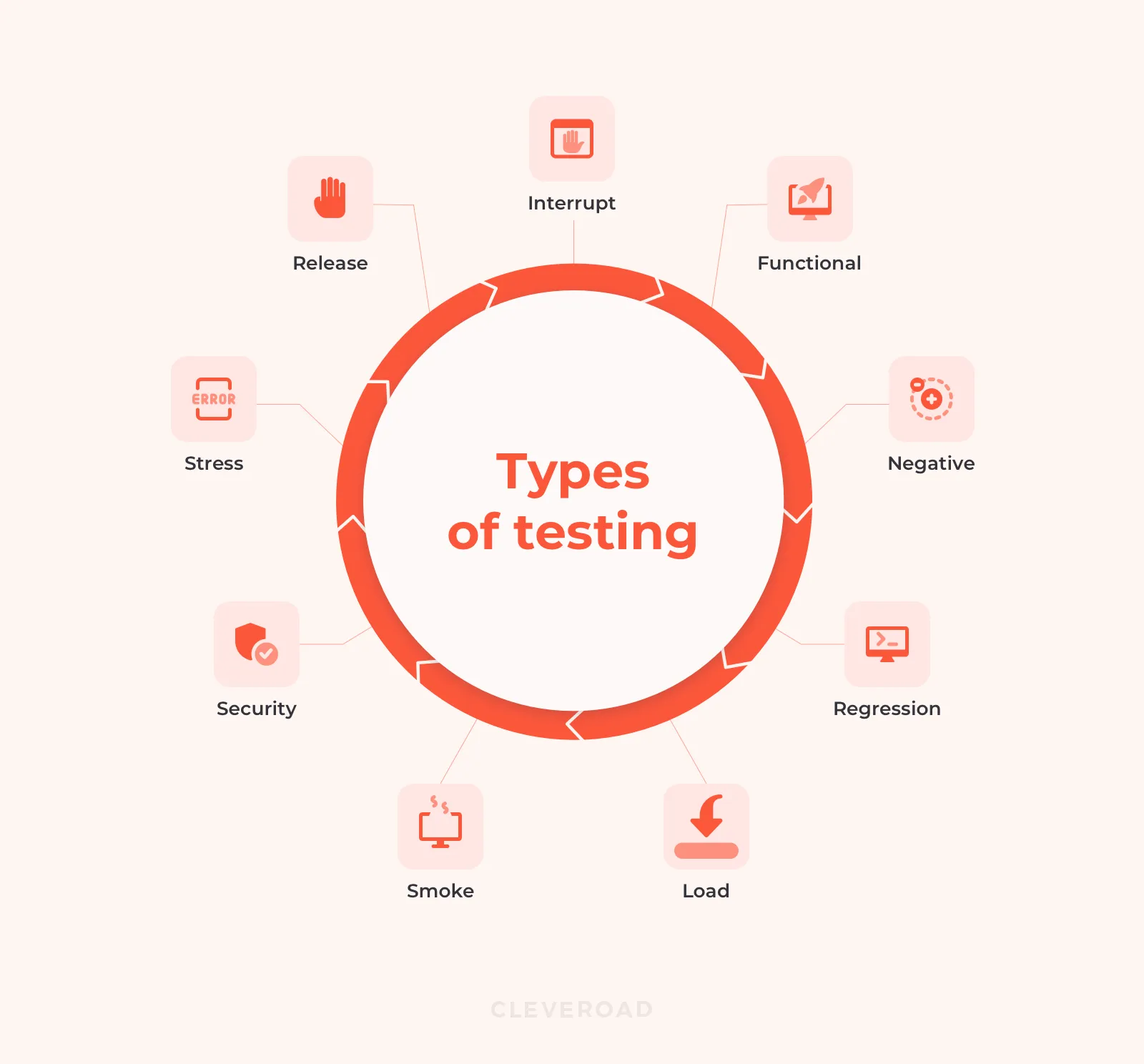
Cycle of performance management
Key principles of the IT performance measurement system are the following:
- Customer orientation. Interests of the customer are the most important for the company;
- Business processes management. Skill to handle different types of activities that create competitive advantages for the company;
- Workflow optimization. The reduction of bureaucracy, elaborate team structure leads to a more stable and efficient work process.
Factors that affect the performance of the software development company
We will list some main factors that have a direct impact on the company's success.
Decisions made by the business owner. Depending on what business approaches and strategies owner builds, it has a direct impact on the development of the company and it's future success.
Customer behavior. Customer orientation is an integral part of an information technology performance management system. A company should build business strategies on the basis of customer interests, the success of the company depends on it.
Business processes organization. Proper organization of business processes will influence the implementation of such important factors like a deadline, quality, and price for software products.
Staff contribution. Motivation and professional competence of software developers can activate the wheel of business success.
Benefits of performance management
It is worth noting that performance management has many strong benefits that should be used not only in the IT industry but also in other fields of activity. That is why our main goal to show you how the advantages of performance management help our company arrange a profound workflow.
Way to profit
When implementing performance management system in IT companies, it makes it possible to build a thorough plan of a software development process that will spell everything out, all required goals are described and the route from A point to B point is indicated. Thus, financial expenditures related to the development can be fixed and it leads to the reduction of unnecessary expenses and the profit growth. Thus, right forecasting allows specialists to save the resources of the company and bring more profit. Besides that, managers can distribute work according to the skills and capabilities of each employee.
Motivation comes first
A development team should know the reason why they create this or that project. How to improve performance management? So the system of bonuses and additional sweets for all team participants should be applied. Apart from bonuses, flexible schedule and detailed requirements also facilitate the high-quality development process, that is why employees should be motivated to move further and do their job efficiently.
In addition, employees should see a feedback from team leads and project managers when they offer interesting ideas concerning how the website or app can be enriched, what technologies they can use in this project and so on. So, when employees feel support and help from their colleagues, they tend to be more productive in the implementation of their scope of work.
Elaborated management control
If there is a detailed set of requirements, a project manager can make a plan for the development process and distribute all tasks according to the skills of each employee which will be involved in this project. Team leader of each department can help a manager find the right specialists for each goal. Thus, a manager can monitor and control the overall fulfillment of assigned tasks with the help of IT performance management tools and provide a customer with each sprint of the project on time. It makes the management process faster and more meticulous, besides that it saves lots of time.
We, at Cleveroad, use this principle to provide the development team with a continuous and trouble-proof workflow. That is why we can submit a high-quality product to our customers.
Enhanced interaction and better team building
Due to properly planned performance management in IT companies, there is always allotted time for meetings and discussions required for a specific project. All participants can discuss each nuance and detail that arise during the implementation, and specialists can find the best solution to each problem together. Better interaction process facilitates the team building and makes the development process more solid and productive. Permanent communication with each other help always stay tuned and exchange useful information concerning the project.
Figure out the main ways to create an MVP. Read Building a minimum viable product: the way to ensure the reliability of your software
Potential growth
An effective approach to each employee with a performance management system helps reveal the full potential of each employee and let them improve their skills. Right motivation, bonus systems, and other additional benefits are a good kickstart for all specialists. Professional development is important both for an employee himself and for the company's management as well.
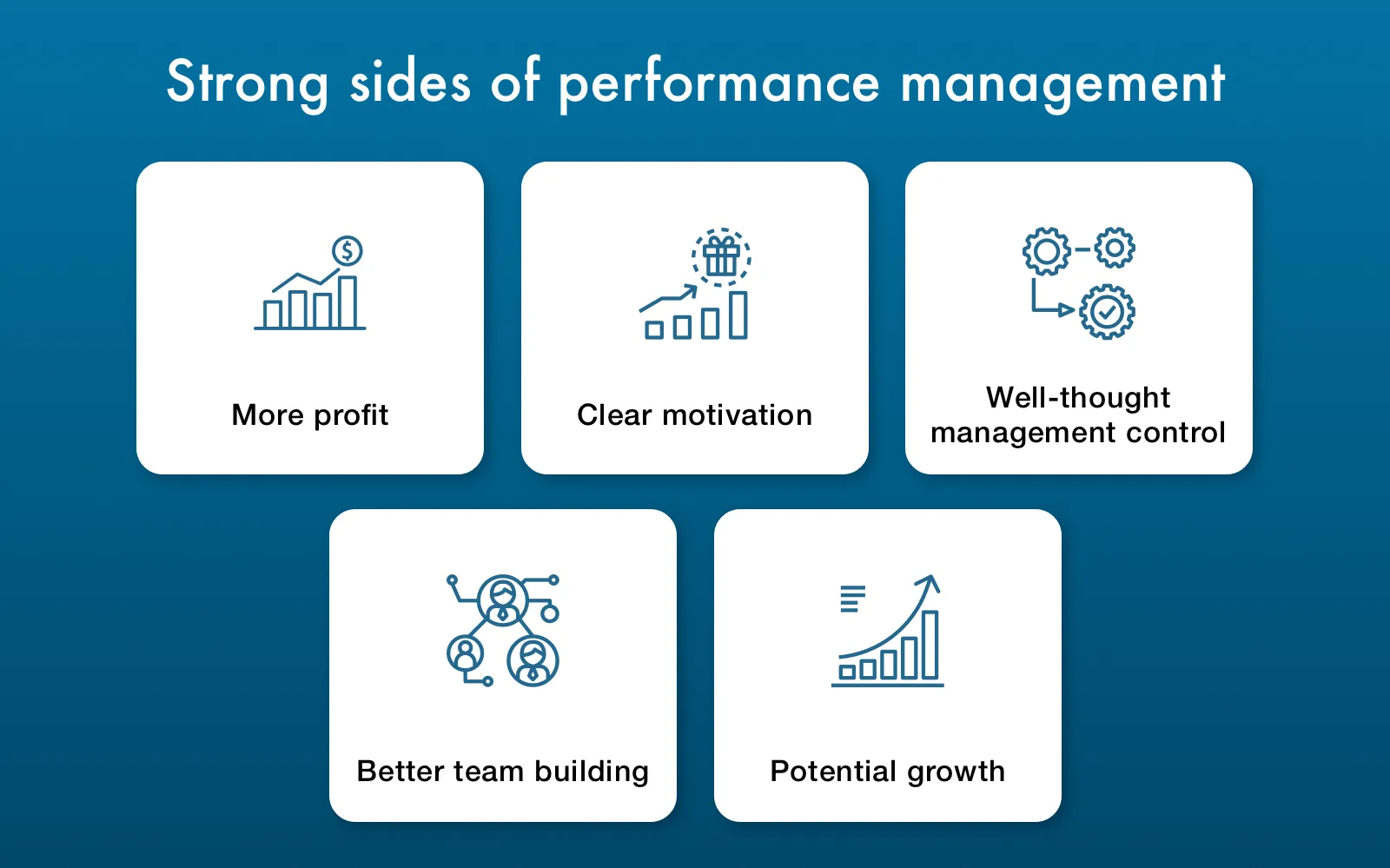
Advantages of performance management
In fact, a performance management system gives a company an opportunity to set right goals, elaborate all plans thoroughly. At Cleveroad, we make use of all these advantages to build the most powerful software development team. What strategies do we use to achieve it? Let's check out the main important strategies below to let you know how to implement performance management.
8 important steps to implement performance management successfully
It is very important to keep up with crucial steps if you plan to implement a performance management system to the fullest and get a profit eventually. Key strategies that work are at your disposal and you can find here how to measure performance management.
Step 1. Delineate your goal
Business strategy should be drawn up as the separate document, it should be written on the paper. It is necessary to define all business activities you want to succeed in and get a competitive advantage, become an interesting company for customers. The process of goal setting should include the collaboration between a company's CEO, project managers and involved employees to think over a right point of business. A goal should be represented specifically, precisely, without any ambiguities. It should contain the main touchstones with described expected results.
Step 2. Prioritize goals
All goals will be coordinated if you will put them into a strict hierarchy - from the highest to the lowest. It is highly important to formulate all goals clearly and in detail, it is not enough to indicate a general field of activity. The goal should create a call to action for you. IT performance management process should include concreteness, realism, measurability, and clear time frames. Based on this, we can see what we want to achieve and how much time we plan to spend on it.
Step3. Monitor the progress
When all details are clarified and the working process is already begun, it doesn't mean that everything will go like clockwork. Managers and team leads should monitor the progress on goals implementation and achievement according to the set plan. If something goes wrong and specialists have some troubles with task implementation, team leaders can help them find the right solution. It will help review a performance level of each employee and change their focus timely if it is necessary.
Step 4. Appraisal and feedbacks are important
After each completed sprint (or the whole project) team leaders should make appraisals of the working process of each employee. Having collected the entire information about the progress level of each employee, team leaders should give constructive feedbacks to employees to discuss all gaps and achievements that were done during the project implementation. Feedbacks are very important since they provide specialists with a necessary information on what they should learn, what weak sides they have and how to develop new skills. Thus, thorough appraisals and detailed feedbacks can help employees upgrade their skill level.
Step 5. Control all collateral processes
When developing the plan and strategy, mind to note all troublesome processes that may have a negative impact on the working progress on different stages. Simply put, it is necessary to detect potential threats. Such threats may include overburdened specialists, overtimes, deadlines violation, complaints from customers, lack of clear priorities, lack of responsibilities frames and so on. So apart from the monitoring of the development process, it is very important to ensure that other processes move in the right direction.
Step 6. Improve relations with customers
Best results can be achieved only team understands the value of each customer. That is what we put on the top - interests of our customers. There should be a permanent tendency to the improvement of relations between management and customers, managers should predict the expectations and demands of customers, and market analysis can come to the rescue here. So, service improvement, ethical standards, business aesthetics (good-looking workplace, the appearance of employees) should be taken into account. As a result, your team will be oriented on high results and it will have the right priorities and goals.
Step 7. Make a solid team
Despite the fact that this point is a little bit different from others, it is also very crucial. To make a solid and reliable team, we provide them with interesting events on their day off, we facilitate their joint time spending beyond the workplace. A wise team leader will control this process since a good collective weekend along with collaborative work make a team really stronger and their relations become more solid. Team building means a lot.
Step 8. Let your team develop
It is very difficult to find high-skilled specialists today, and it can be a normal situation if developers lack some skills. That is why it is necessary to give them an opportunity to learn and gain new skills, apply flexible schemes of training, choose a mentor for them from an experienced staff. As for Cleveroad, we always look for young talents that don't have large working experience but they have a hot aspiration to learn and work. We give necessary knowledge to our trainees and let them become a reliable part of our development teams.
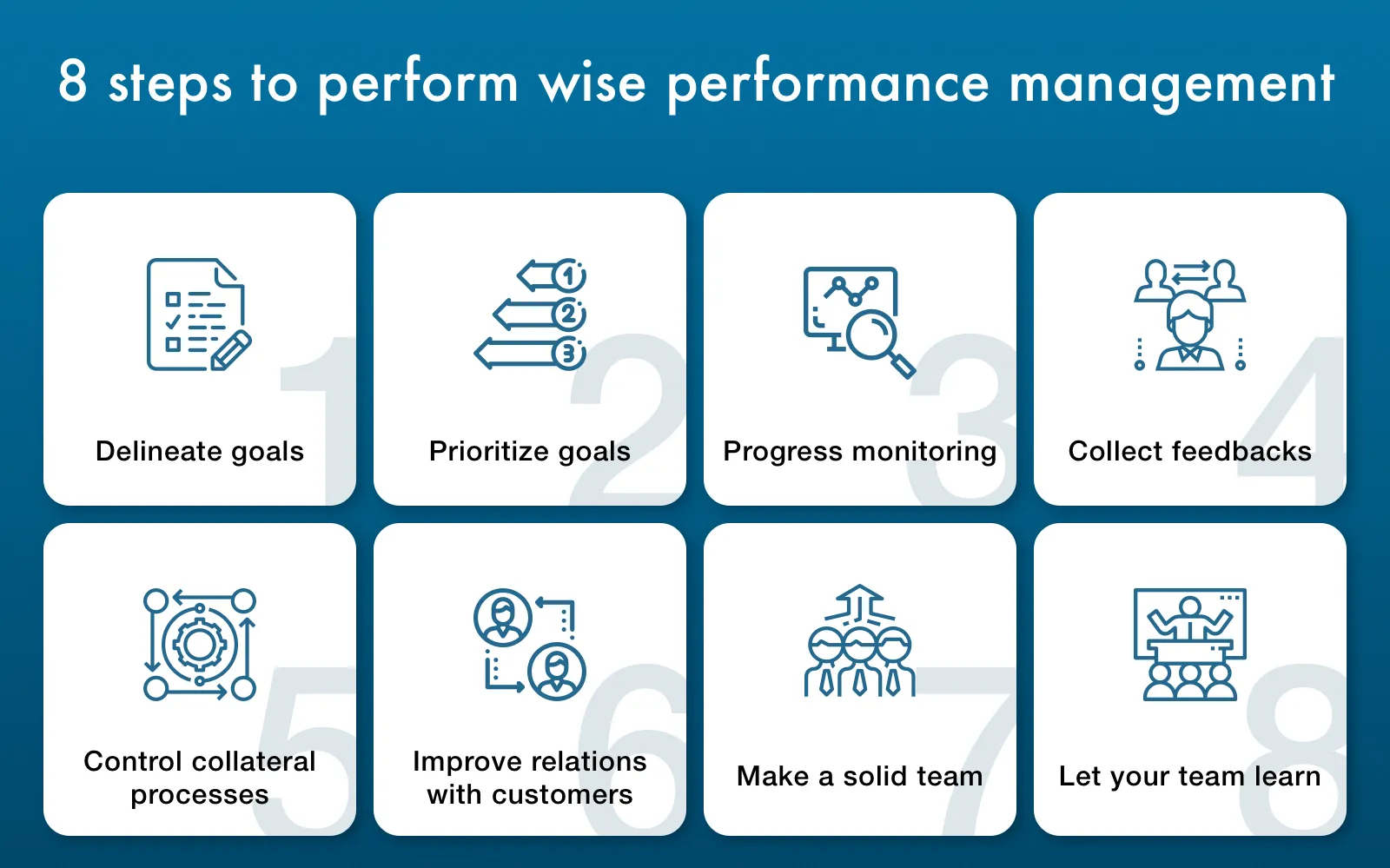
Steps to integrate performance review wisely
Catch on a useful guide to form a mobile app development team. Read mobile app development team article
Having listed all important strategies, I would like to show you the example of how we make a project plan for the development of an on-demand app to manage performance and control all necessary processes.
On-demand app development: how we control project development flow at Cleveroad
This process includes a few crucial and must-have steps.
Conditions
- Different developers set for a new project;
- Project duration: 3-5 months;
- Team: 1 sales manager, 1 RA (requirement analyst), 1 project manager, 1 designer 1 QA specialist, 1 backend developer, 1 client-side developer (web front-end, iOS, Android).
Process
- Sprint 0 or Planning - create a specification and confirm it (along with wireframes);
- 6-10 Development sprints - from Specification to Release.
Basis for Planning
First, we make estimates. Once we have an estimate and a contract has been signed up, a project plan can be created. During this stage, we keep the deadline and consider risks.
Project plan
It is required to select a development methodology. Classical used: SCRUM.
Create plan
Basic organizational activities + Frameworks + Features development + Feedback implementation (optional) <= 80h per developer per sprint.
Thus a plan for 1 and more sprints can be created. Part of sprint example is shown below:
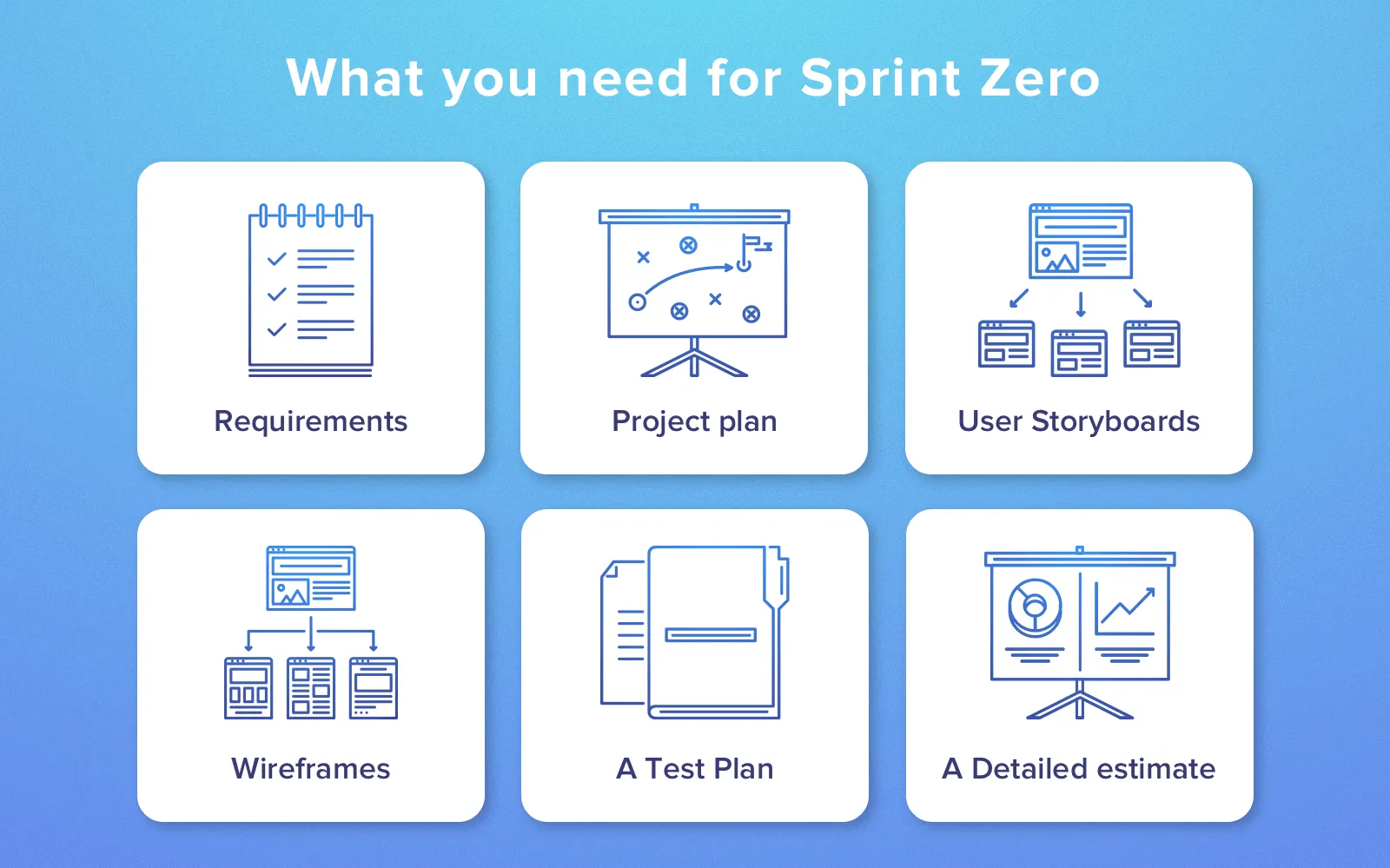
Sprint example for back-end part
Development
Set Rules
- Communication;
- Aim for each sprint;
- Code freeze and demo dates.
And watch their execution.
Watch progress
Do you want to know more about the development process at Cleveroad? Then hurry up to watch this video:
Development Process at Cleveroad: How We Create Software
Develop
Quality Assurance
Final test
- What was done;
- What was not done;
- Why it wasn't done;
- How to do it further;
Look back at the retrospective. Allow everybody to improve the process. It takes 1-3 sprints to build a team which communicates well. What to do? Facilitate. Help. Resolve. Communicate. Watch if the release is performed in time.
Release
Prepare everything necessary 1 sprint ahead. Make deployment. Perform testing. Submit builds.
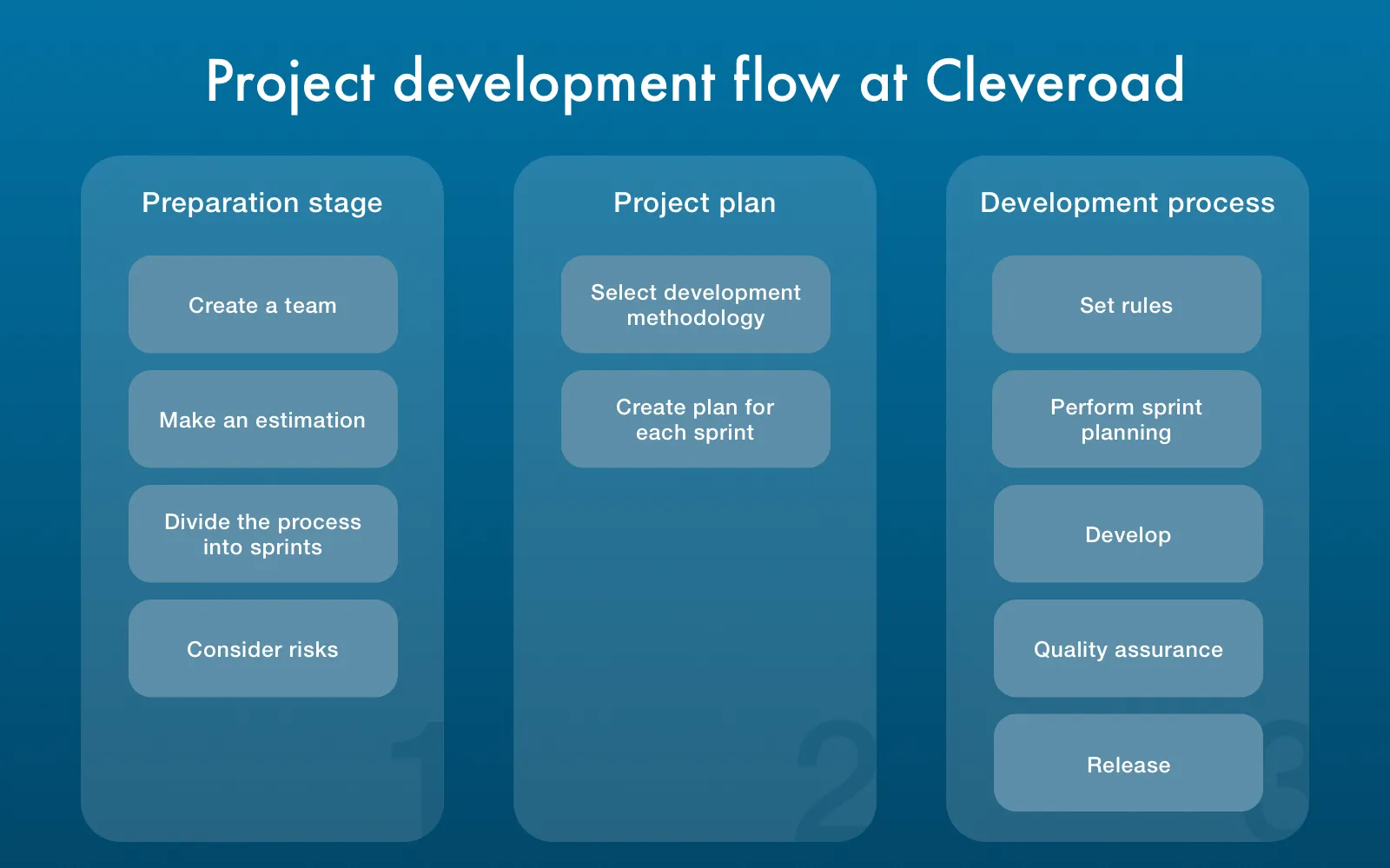
How we create project plan at Cleveroad
Learn more about project planning phase. Read Project planning phase and hour team approaches it
That is how we manage to control the performance of our employees and create a high-quality product. If you have any questions or you plan to build your mobile app or website, don't hesitate to contact us right now! Also, subscribe to our blog - you can see the button on the right side!
Performance management has a lot benefits that help arrange profound workflow:
Way to profit Implementation of performance management helps to build a thorough plan that forecasts workflow. Right forecasting leads to resources and funds savings.
Motivation Flexible schedule and detailed requirements facilitate the high-quality development process and gives a motivation to the team.
Management control Defined requirements helps to make a plan and set tasks according to the skills of the team. It would be easier to manage fulfillment of the tasks.
Enhanced communication Due to properly planned performance management in IT companies, there is always allotted time for meetings and discussions required for a specific project.
Potential growth An effective approach to each employee with a performance management system helps reveal the full potential of each employee and let them improve their skills.
Performance management process consist of several steps:
- Step #1. Define your goals
- Step #2. Prioritize goals
- Step #3. Monitor the progress
- Step #4. Give feedback on the progress
- Step #5. Control all collateral processes
- Step #6. Improve relations with customers
- Step #7. Make a solid team
- Step #8. Let your team learn
Performance management methodology can be represented as set of solutions that has three main factors:
- Data collection
- Analysis and building on its basis
- Keeping up with built model
There are three main principles of IT performance measurement system:
Customer orientation Interests of the customer are the most important for the company.
Business processes management Skill to handle different types of activities that create competitive advantages for the company.
Workflow optimization The reduction of bureaucracy, elaborate team structure leads to a more stable and efficient work process.

Evgeniy Altynpara is a CTO and member of the Forbes Councils’ community of tech professionals. He is an expert in software development and technological entrepreneurship and has 10+years of experience in digital transformation consulting in Healthcare, FinTech, Supply Chain and Logistics
Give us your impressions about this article
Give us your impressions about this article